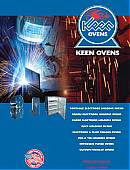Industrial Ovens
Front-Loading
![]() Under 10 cubic feet
Under 10 cubic feet
![]() 10-20 cubic feet
10-20 cubic feet
![]() Over 20 cubic feet
Over 20 cubic feet
![]() See All
See All
Top-Loading
![]() Under 10 cubic feet
Under 10 cubic feet
![]() 10-20 cubic feet
10-20 cubic feet
![]() Over 20 cubic feet
Over 20 cubic feet
![]() See All
See All
Learn About Our Industrial Ovens
Welding Ovens
![]() Stick Electrodes
Stick Electrodes
![]() Sub-Arc Flux
Sub-Arc Flux
![]() Wire Spools
Wire Spools
![]() Tig Filler Wire
Tig Filler Wire
![]() Multi-Purpose
Multi-Purpose
![]() Nitrogen Purge
Nitrogen Purge
![]() See All
See All
 Order Our Free Catalog Today Click Here |
| Available Inventory |
Heat Treating MetalMan oh man, is it ever hard to do a brief article on heat treating! I'm usually pretty good at summarizing technical information, and putting it into layman terms. However, with heat-treating there are a lot of complicated definitions and explanations. Fortunately, for me there are some good resources on the web and I'll list them in my conclusion on pre and post-heat treating. It is good that more people are starting to realize how important pre and post-heat treating can be depending on the steel used. It is a real shame how many welders out there know nothing about the steel they are welding on. To be a good hand, you HAVE to know about the steel you are working on, by knowing what takes place when it is heated and cooled. I once stopped a guy who was going to use re-bar for rungs on a ladder for a 200-foot tall tower. What he didn't realize was the re-bar has a high carbon content and when heated and rapidly cooled becomes brittle. Therefore, when some 220-pound Iron Worker with 35 pounds of tools hanging on his belt, stepped down on one of those rungs it could have easily broke. NOT a good scenario 200 feet in the air! In steel there are microscopic crystals, some bigger than others. The smaller the crystals, and the closer they are to each other, the more strength, and hardness. However, with that comes the downside of the steel being brittle. The larger the crystals, and the farther away from each other, the steel will have less strength, but will be more ductile. (flexible) Using dashes from my laptop keyboard
let's say the small, close ones are from the high strength steel on my pocketknife
blade… ___ ___ ___ ___ ___ ___ ___ ___ ___ ___ ___ ___ ___ ___ ___ That's why the old timers changed from cast iron to mild steel when they started building upwards back in the day. Cast iron would crack and shatter when loads shifted from wind or weight of the floors built. With mild steel the building will flex, yet return to its original shape. Another advantage is that mild steel is not changed much when heat treated, thus welding in the field has little effect on the joints. When welding, there is a HAZ (heat-affected zone.) The steel on each side of the weld is heated by the welding process, and then cooled when the weld cools.
Cast Iron MUST be pre-heated and post-heated to slow the cooling process or it will crack. When repairing a crack on cast iron it can be very frustrating when the crack spreads just ahead of the welding pool. This can make even the most laid-back welder want to punch a wall! Drill a hole in front of and at the end of the crack. Pre-heat, weld, then post heat and cool. The hole will keep the crack from spreading, and after properly welding the crack, you can fill in the holes. Learn more about out Batch Ovens. |